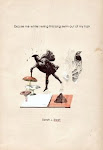This is the current stop on the virtual tour of A Walk Through The Memory Palace by Pamela Johnson Parker, sponsored by Read Write Poem. The chapbook is a steamy one, full of hot weather and heat-slick slugs, sexual desire, family relationships, the body and iced tea. It teems with color and flora, and I almost wished I’d read it in summer rather than a German snowstorm. Parker is a poet obviously entranced by sound, hepped up on nature and attuned to emotion.
I went two ways on the collection. There was a lot that I enjoyed, including many images and the use of sound. I appreciated the subject matter and I admired the craftmanship, its attention to linebreaks and structure. On the other hand, there were a couple things that weren’t my cup of meat. I’ll touch on them later. And, before I go on, you should know there’s a marvelous website devoted to this book, where you can not only read the poems but also listen to the poet read. Do that.
The first striking image in the book occurs in the first poem, 78 RPM. Here, an adolescent couple, sometimes chaperoned by an aunt, are hanging out on the porch listening to music. The poem is slow, in a good way, also because it’s hot out, and there’s an audible undergurgle of teenage longing, and all the senses are engaged. Halfway through, there’s a suggestive image of the needle as it drags along the vinyl record.
“The stylus traces
Its sapphire finger
Down the record’s groove,
As he skates a single
Finger along the sun-
Bleached down of your
Arm”
Not that y’all wouldn’t have gotten it, but these lines clearly evoke the vagina, like a fuzzy groove in a record, like a closed purse about to be plumbed, and BOOM! it is a very sexy poem.
My favorite poem in the book is probably Breasts, the last one. Actually, I’d usually scrunch my nose up at a poem about breasts, the poor things have been so romantized and adored and exploited for literary purposes. Parker doesn’t ignore the symbolic baggage of breasts – nurturers, sirens, cancer factories – but she handles the subject well, and in all those guises. The poem is broken into six parts - Figures A to F –each segment prefaced like a text book illustration, as in “Figure D. Table showing statistical survey of definite tendency toward the development of breast cancer among family members.”
Figure A shows a woman inspecting her breasts in a mirror. It’s an intimate shot, adoring but respectful. Very tactile, very sensual. Figure B is similar, showing a woman examining her breasts laid back in bed with the fingers circling the breast “inward like a nautilus,” an image I liked a lot.
Figure C is the absence of breast after a masectomy. The body in this segment comes across as hide, as material, a bother, a wound. The scars are like zippers and the chest is disturbingly nippleless.
Figure D harks back to childhood where a girl observes her grandmother’s wobbly breasts, and is glad to be yet undeveloped. But the tree from which she observes is “weighted down with a pearly spray of bloom,” and the child shakes the branches knowing some day she’ll “sag like gran.”
Figure E is my favorite part of the poem. The subject is the speaker’s boyfriend, a pathologist working in cancer research. I like this segment for its distance, its clinicicity and it’s humorous last line, where the boyfriend tells the speaker, “You’ve got great lungs.”
Figure F has the speaker up late nursing her daughter when she gets a call from her sister with the news the sister has breast cancer. This is the emotional apex of the poem and the book and, while it packs a punch, I would have liked it served up more subtly. As it’s written, the speaker learns of her sister’s cancer while clutching her baby to her breast... Nevertheless, I liked “Breasts.” It’s an honest poem that works like a 360 degree examination.
Parker pays close attention to sound, and, regarding structure, is an impressive craftswoman. If I have a quibble with the book, it’s that sometimes it reaches too far for me for what is traditionally considered “poetic,” for example with alliteration, such as the “feathering fronds of seafern” in the poem “Engendering.”
In the same way it brings scrolls of beautiful language, which, while pleasurable, don’t seem to serve to convey much beyond themselves. The poem “Unreal Gardens with Toads in Them” begins “Today’s listless, nothing to / enumerate — no light / in its hues of jade, and no white- / green heads of hydrangea, / no dark hearts of redbud leaves, / no celadon of the sun- / lit maples, no sea-green treefrog’s / back with each inclusion / of amber and topaz (though he’s / never seen the sea, why / not sea-green?), no silver-tipped spears of lavender now / poking up in the herbal bed —“
By that point, I wanted a reference point and lacked it. This is all, of course, a matter of personal taste. Parker’s chapbook took first place in Quarrtsiluni’s Chapbook Contest, judged by Dinty Moore. As it says in Moore’s blurb, “this poet sees through the obvious to something radiant on the other side, painting a startling portrait of an intimate world.”
All the info on this tour can be found here, including past reviews and those upcoming.
Subscribe to:
Post Comments (Atom)




1 comment:
I read your favorite, Breasts, and found the clinical approach very compelling, especially the last line, "I hold you tighter to my breast."
Post a Comment